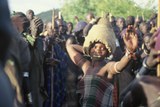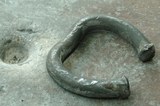Bracelet fighting (ula)
Mun (Mursi) women often evaluate themselves and others by their strength and ability to ‘strike iron bracelets’ known as ula. Women also like to draw comparisons between girls’ ula competitions and men’s dônga (competitive stick dueling). In fact, it is not unusual to hear women and men refer to bracelet dueling as “dônga a dholuiny” (girls’ dônga). The dueling weapon, or ula (pl. ulen) is made from a rod of iron and is pounded and smoothened to snugly fit a girls’ wrist. There is an opening on the inside of the wrist with two rounded nubs on either side used for striking one’s opponent. As with all girls’ and women’s bracelets (siggiyo), a slight indentation is made on the topside of the bracelet for aesthetic reasons.
As a girl grows up, ideally, she will earn a reputation as a “strong girl” (dholey ôdhinêna). The ula is thus a symbol of such strength, since only ‘strong’ girls and women are said to be worthy of wearing it. Two women, Ngatui and Nyabissê Sabakoro maintain that, “If you are a weak woman you will not wear an ula. Only a strong woman—a real oli [bull]—can wear it! If she is really powerful she will wear an ula on both [wrists] and have many bracelets (siggiyo)” (LaTosky 2013: 119). Even though other factors besides strength, such as the wealth of a girl’s family, will also determine whether a girl owns or wears an ula, what is interesting is how people talk about the ula in terms of personal strength. In the everyday narratives of women and men, the ula competition is discussed as a kind of performance intended primarily for a male audience. As Bamille Dorowa puts it: “If a girl’s hands are swift like a healer’s, the men will talk about her and say: ‘So-and-so’s daughter is really strong! I really want that girl. Whose girl is she?’ Olisirwa Tulla puts it in a similar way:
The bansanaa [‘big’ girls, i.e. have reached puberty] and nyawalalnaa [pre-pubescent girls with stretched earlobes] and ngonikongowa [young girls aged roughly 5-9] fight—all the girls! The têrro [age-grade of young men] and rora [warrior age-grade] watch them carefully—tull (::)! We will say: ‘Look, that girl will fetch water quickly. I want to marry that girl!’ The banasanaa are really strong; they are not like women who become weak after they get married” (LaTosky 2013:115).
Only young, unmarried girls (bansanaa, nyawalalnaa and ngonikongowa) practice for and compete in the ula competitions, which generally follow dônga duels. They are said to be an important part of girl’s education and a reflection of her future skills and strengths as a wife and mother. Both stick dueling and bracelet competitions depend on the success of a harvest, well-being in the community, and the participation of different clans.
Like young men, girls also have “victories” (bolisay), only they are not etched in trees, but recalled in personal stories. As Nyabissê Sabakoro explains:
We know where our scars came from and how many victories our friends have. We fight with the girls from other clans and later we become friends. If you hit a girl in the mouth, that is a win. If you hit her in the side and she bends over that is a win and the fight is over. The referee (kwethani) will raise his/her arms like this and push you apart. There is also a referee in girl’s bracelet fights—men and women can be referees. I only have one win. If the blood comes [pointing to her forehead] you are a real bansaanai (winner). A bansaanai has her lip pierced and stretched. If my lip was stretched, I would tuck it in with leaves like this or else the ula would tear it open! (LaTosky 2013:118)
A girl with a torn bottom lip, earlobe, or multiple scars on her forehead might therefore be taunted as being “weak,” or “like a Ngidi” (Kwegu, i.e. without cattle, poor), or “unfit to marry even a Chachi” (Chai) (ibid.). Whenever I asked women about their abilities to fight ula they would often respond with the rhetorical question: “You don’t see any scars on my forehead do you?” This is because numerous scars on a woman’s body are a sign of weakness. For men, on the other hand, numerous scars on one’s body are said to be a sign of strength, since this indicates that he has participated in many dônga competitions.
As Abbink also explains for men’s dônga in Suri “displaying courage in fighting is said to be more important than winning. Wounds and scars are shown with pride” (1999: 233). Similarly, it is not uncommon to hear Mursi women refer to young men with few scars on their bodies as a “loya” (weakling) or a “hira kobotey” (someone who does not know how to protect or defend himself). Like dônga, ula competitions are an important means of conveying courage and sociability among children and adults. Just as boys are taught to fight with dueling poles from childhood, girls are taught to strike with their bracelets from a young age. This way they learn how to properly defend themselves and how to, later, be able to publicly convince themselves and others of “their suitability and strength for adulthood, marriage, and reproduction, all of which are deemed necessary for gaining higher social status” (Abbink 1999, quoted in LaTosky 2013: 119).
By Shauna LaTosky
More information
LaTosky, Shauna. 2013. Predicaments of Mursi Women in Ethiopia’s Rapidly Changing World. Cologne: Köppe Verlag.
Abbink, G. J. 1999. Violence, ritual, and reproduction: culture and context in Surma dueling. Ethnology 38 (3):227-242



